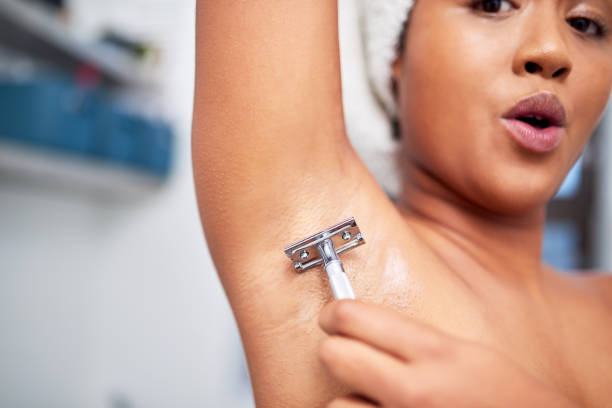In recent years, there has been a surge of interest in traditional shaving techniques for both men and women. This is particularly refreshing considering the modern era's focus on disposable razors and electric shavers. Today, we will explore the beauty and benefits of embracing traditional shaving techniques for women, offering insights on how to achieve a luxurious, eco-friendly, and cost-effective shave.
The Allure of Traditional Shaving:
-
Personal Connection: In a world full of automated gadgets and impersonal interactions, traditional shaving offers a moment of connection with yourself. The process of preparing your skin, applying the lather, and gently guiding the razor requires mindfulness and attention to detail. It can be a soothing and meditative experience that leaves you feeling refreshed, both physically and mentally.
-
Sustainability: The use of traditional shaving tools like safety razors and straight razors is not only a nod to the past but also a significant step towards a sustainable future. By choosing these reusable tools, you are drastically reducing the amount of waste generated by disposable razors. Additionally, many traditional shaving soaps and creams are made with natural, eco-friendly ingredients, further contributing to a greener planet.
-
Cost-Effectiveness: Although the initial investment in a traditional shaving kit may seem steep, the long-term savings are substantial. High-quality safety razors and straight razors can last for years or even a lifetime, with only the blades needing occasional replacement. This contrasts starkly with the constant need to purchase disposable razors or replacement heads for electric shavers.
Getting Started:
-
Choose Your Tools: The first step in embracing traditional shaving is selecting the right tools for you. A safety razor is an excellent choice for beginners, as it provides a close shave with less risk of nicks and cuts compared to a straight razor. If you feel comfortable, you may eventually transition to a straight razor for an even closer and more luxurious shave. Click HERE to view our collection of Safety Razors.
-
Invest in Quality: When purchasing your shaving tools, opt for high-quality products. A well-crafted razor, along with a badger or synthetic shaving brush, will make all the difference in your shaving experience.
-
Learn the Technique: Educate yourself on proper shaving techniques for your chosen tool. This includes learning how to hold the razor at the correct angle, applying the right pressure, and mastering the various strokes. Take your time and remember that practice makes perfect.
-
Prepare Your Skin: To achieve the best results, you need to properly prepare your skin for the shave. Start by exfoliating and cleansing your skin to remove dead skin cells and open up the pores. Then, apply a pre-shave oil to soften the hair and create a protective barrier. Click HERE to view our collection of Pre-Shave Oils.
-
Create a Luxurious Lather: A high-quality shaving soap or cream is essential for a smooth shave. Using your shaving brush, work up a rich lather, which will help to lift the hairs and provide a cushion for the razor to glide across your skin.
- Aftercare: Complete your shaving routine with a nourishing aftershave balm or lotion to soothe and hydrate your skin, preventing irritation and redness. Click HERE to view our collection of Aftershave Balms.
Embracing traditional shaving techniques for women offers a plethora of benefits, from the personal connection and mindfulness during the process to the positive impact on the environment and your wallet. By taking the time to learn and practice these techniques, you will not only enjoy a closer, smoother shave but also cultivate a unique and luxurious self-care ritual. So why not give it a try and rediscover the beauty of this timeless tradition?


1 comment
Good post. As an eager “new” lady wet shaver, I could wish there was more information out there geared to women (or to any person who body-shaves, actually). But through YouTube I did find plenty of helpful information, even one or two videos with women demonstrating actual wet shaving techniques. However, there wasn’t a lot of detail. I have been on the journey for months now, and over time I have found out what works best for me, and that is more than one razor, blade, and system of shaving. For example, when I need to shave my legs I typically draw a hot bath on a Saturday or Sunday, and take plenty of sweet time to complete the task. If/when I don’t have that time, but still need to shave legs (as opposed to other smaller areas like underarms or bikini area, which are pretty easy to do even at the sink) I do it in the shower, and for that purpose I have a totally different razor (Muhle Companion), lather system (silicone travel bowl, inexpensive small boar brush) and soap (for shower shaving, I use a cream, and usually one in a tube for easy and quick dispensing). One thing I don’t think women understand well is how much difference blade type can make. I didn’t realize it either, and I bet there are women out there that have tried safety razors and been turned off because they used a dull, inferior, or used blade. Also I’m shocked by how many women try to avoid using a cream or soap when they shave. For me, that’s instant and seriously painful razor burn. I also would not recommend using a shave oil if you are also using a cream or soap. Oils kill lather and suds. Use a real pre-shave like Proraso -I use the white line and it smells lovely-or suds up well with glycerine-based soap and let it sit for a couple of minutes before shaving to soften up the hair.
I’m about to travel and DE shave for the first time and I’m looking forward to it, and to figuring out what works best for travel. I have the Parker travel razor, which is a very short-handled razor. Now while that doesn’t work as well for me as a longer handle for my legs, it works well enough and fits in a tiny package—leaving more room for me to pack a full size brush because ladies, those tiny travel brushes are just not all that helpful for painting on lather for larger areas. I actually plan to use my Simpson’s Trafalgar T3 synthetic brush as a travel brush—it’s got a 30mm knot, which sounds huge, but with a synthetic it looks more like a 24mm badger knot. I wouldn’t want to go smaller. I have also found that for at-home shaving, I much prefer natural (badger or boar) hair brushes, because they “splay” or spread out and a 28mm knot becomes much larger —which paints on and creates more lather more quickly, either in a bowl or on my skin. For travel, a synthetic makes sense for me because the bristles dry out quicker and it’s less of an investment if it does get lost. These are some tips that may help others who shave body hair regularly. Thanks for posting these blogs.